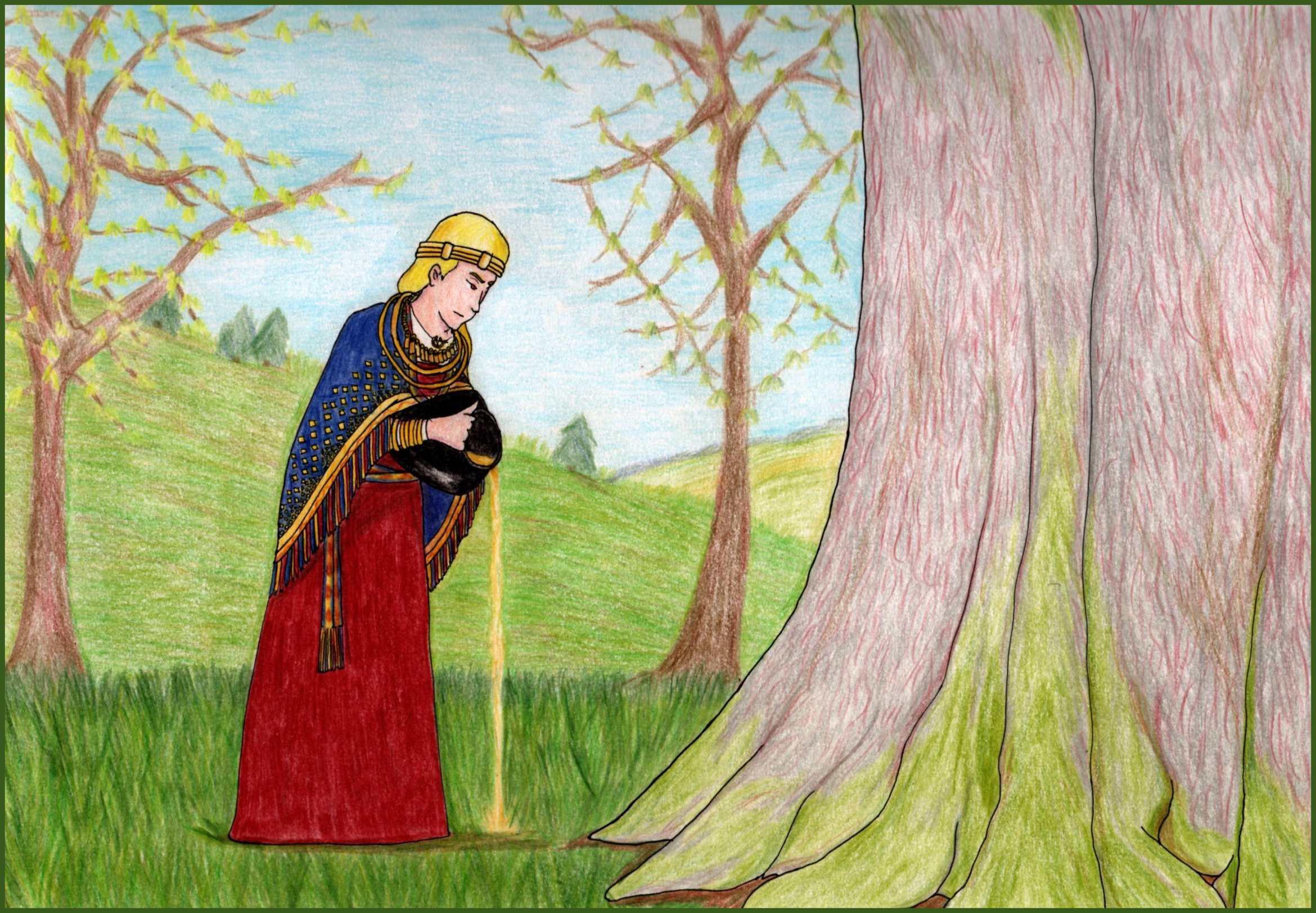HOME | DD
 Eldr-Fire — The Devotee of Zemyna
Eldr-Fire — The Devotee of Zemyna

#1000 #baltic #goddess #history #lithuania #medieval #oak #pagan #woman #women #womenof1000 #womenof1000ad #baltics #balticsea #goddesses #goddessofdeath #historical #historicalcostume #historicalplace #lithuanian #medievaldress #oaktree #oaktrees #paganart #pagangoddess #paganism #balticstates #historicalfashion #medievallady #medievalwoman #historicallyaccurate #medievalwomen #goddessqueen #goddessworship #historyfashion #historyart #historicalperson
Published: 2020-03-03 15:50:21 +0000 UTC; Views: 2474; Favourites: 50; Downloads: 3
Redirect to original
Description
Although Christianity was spreading in earnest across Europe, it had not yet reached the Baltic. Here, the people continued to practice the old ways of their ancestors. On holy hills and in sacred groves, they gathered to make offerings to the gods and goddesses on whose benevolence they depended. Among these was Žemyna, the Earth Mother. The source of all life, her people made regular sacrifices to her. One of the most common offerings to her was beer, which her worshipers poured into the ground at the beginning of every festival.Although she was a goddess of life, Žemyna was also a chthonic goddess, tied with the earth and death. Other gods lived in the sky, but her home was in the earth. She was known by many names: they called her the Mother of the Sands, the Mother of the Graves, and the Mother of the Ghosts. But for the medieval Balts, the divide between the worlds of the living and the dead was an illusory one, and so Žemyna's role encompassed the forces of both life and death. One of the aspects of life under her care was childbirth. When a child was born, often in a sacred bathhouse, offerings were made to Žemyna as well as Laima, the goddess of luck. Women would share a special, sacred meal on these occasions. While all people worshiped the Earth Mother, she had a special connection with women. She was one of the only deities thought to directly oversee human welfare, and so she was petitioned often.
But how did Baltic women communicate with their gods? An account of a 14th century Christian mission into Lithuania gives us some crucial details. John-Jerome of Prague, a zealous missionary, gave an interview towards the end of his life that recorded details of his journey. After being welcomed by the duke, he travelled throughout Lithuania, encountering pagans and trying to persuade them to abandon their faith for Christianity. He was not very popular among the Lithuanians thanks to his aggressive approach; for example, when he found out that each family kept a sacred snake in their house, he ordered all the snakes killed and burned in the middle of the village. He met people who kept a perpetual fire burning, and others who told stories of when the sun goddess, Saule, was whisked away to a tower before the other stars came to rescue her.
While John-Jerome tried his best to dissuade all of these people from their traditional religion, it was when he targeted sacred groves that he met with the most resistance. Early medieval accounts of pagans throughout Europe mention groves as particularly important centres of pagan worship. However, few are so detailed as John-Jerome's account from the 14th century. The Lithuanians worshiped in a grove where all the trees were protected, but one was revered above all: an ancient tree in the centre of the grove. It was probably a giant oak tree, the most common focal point for Lithuanian sacred groves even into the modern day. Like other Europeans, the Lithuanians believed in a world tree, usually an oak where the sun goddess Saule hung her belt as she journeyed below the Earth at night. This tree was considered so sacred that even when John-Jerome convinced some of the villagers to start chopping down the other trees in the grove, they were reluctant to go after this one. The missionary himself had to take an axe to the tree, and he continued to destroy sacred groves wherever he went.
There was one group of people who were furious at this turn of events: Lithuanian women. In a remarkable episode, the women of one of the places where John-Jerome destroyed a sacred grove went to see Grand Duke Vytautas. Demanding an audience with the duke, they told him of how the missionary had "destroyed the houses of their gods, where they were accustomed to seek divine assistance; they no longer knew where to find their gods". The location of their gods was so closely linked to the sacred trees that their relationships with the divine were cut down with every swing of John-Jerome's axe. They worried that the missionary wanted to destroy all their holy places in an effort to get rid of all their own customs. After the women made their case, their husbands, who had "followed their women", chimed in that "they would rather relinquish their land and ancestral hearths than give up the religion handed down to them from their ancestors".
Their protest was successful. Vytautas feared that allowing John-Jerome to remain in Lithuania would cause a popular uprising so unstable that he would be ousted from the throne, so he rescinded his letters of protection and ordered him to leave the country. The strength of these women's devotions to their gods and to the holy groves where they communicated with them was so strong that they were able to remove a powerful and well-connected Christian from their lands even after the duke's official conversion to Christianity. Although Lithuanians would eventually become Christianized, they were the longest holdout in all of Europe. This late date of widespread conversion means that there is an unusually large amount of evidence available about what the pagans of Lithuania actually believed and practised. Even today, the Lithuanians still sing hymns about their pagan gods. Žemyna, for her part, was largely identified with the Virgin Mary, who took on many of her original functions, and Lithuanians still pray in sacred groves around the country, now to saints.
Here in this illustration, we find a Lithuanian woman, one of the ancestors of the 14th century protestors, worshiping Žemyna in a sacred grove. The great oak tree stands before her, surrounded by a row of linden trees in the first bloom of spring. Frowning in concentration, she pours home-brewed ale into the roots of the tree where her goddess resides. Is she thanking Žemyna for the return of spring and the Earth's fertility? Or is her petition a more personal one, perhaps concerning her hopes for a child? In the sacred grove where she seeks divine assistance, that is a matter between her and Žemyna.
I got the idea to work on this picture because my dad is the one who translated parts of John-Jerome's account of his time among the Lithuanians! I had just mentioned to my mom in passing that I hadn't done any Baltic women for my project yet, and she started telling me about women who worshiped snakes and told me to ask my dad for more! It was really fun sitting with him as he read out the parts of the article he wrote about it where John-Jerome described the beliefs of the pagans. The story about the women leading the petition to protect their sacred groves really stuck with me. Then when I found out what beautiful clothing the medieval Baltic peoples wore, I was sold!
This was a really special picture for me to work on. The past few days I've been feeling really happy, and I'm really happy that the days are getting longer and the weather is getting better. Spring is definitely on its way! I also found out while researching this picture that according to family lore, my maternal German family originally came from the Baltic. What a cool little bonus to think about while drawing this picture! I love trees so all the stuff I read about the sacred groves really resonated with me. Now I want to go to the Baltic and see it all for myself!
Learn more on the website: womenof1000ad.weebly.com/devot…
Others in the series include...
Sahiqat
Jigonsaseh
The Explorer of Ua Huka
Mór
The Reader of Ancash
The Skiier of Sápmi
Mahendradatta
Martha Mother of Kings
Miss Zeng
The Singer and Dancer of Calos
Related content
Comments: 11

👍: 0 ⏩: 1

👍: 1 ⏩: 1

👍: 0 ⏩: 0

I really like her outfit! The detailing on the fringe is really nice, and I love her bracelets. This picture has a nice, serene energy to it
👍: 0 ⏩: 1

Aaaaa I can't get over the colours in this one and her gorgeous clothing!!!
👍: 0 ⏩: 1

wow!!! this was so interesting!! and I really liked the personal part of the description, too
and I LOVE this drawing!! the light is fabulous, the colors and the clothes, too!!! and the tree bark and moss are gorgoeus!
👍: 0 ⏩: 1






























